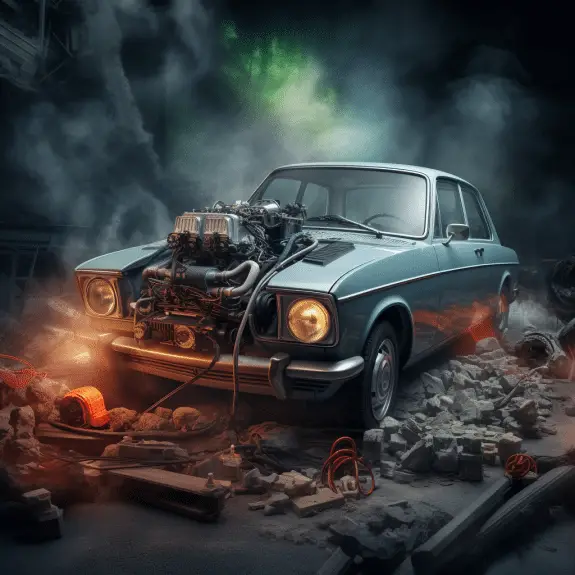
Turbocharged Car Jump-Starting: Safe Practices and Pro Tips
Turbocharged car: If you need to jump start a car with a turbocharger, it’s essential to follow the right steps to ensure a safe and quick rev up experience for your engine in the US. Before attempting a jump start, test the battery’s voltage and ensure a proper charge. If the jump start still fails, it’s advisable to consult professionals and consider the warranty coverage of your battery for potential replacements.

Key Takeaways:
- Having a fully charged battery is crucial when jump starting a car with a turbocharger.
- Using jumper cables correctly is important to avoid potential damage to the turbocharged engine.
- A winch-assisted jump start can provide seamless and quick engine revving for turbocharged cars.
- Refer to your car’s owner’s manual for specific jump start instructions.
- Seek professional help if the car doesn’t start after a few attempts.
Car Battery Basics: Maintenance and Troubleshooting
Before attempting a jump start, it’s crucial to understand the basics of car battery maintenance and troubleshooting to ensure your battery is in optimal condition. Regular maintenance is key to prolonging the life of your battery and avoiding unexpected breakdowns. Here are some essential tips to keep your car battery in top shape:
- Keep the battery terminals clean and free from corrosion. Use a mixture of baking soda and water with a wire brush to scrub away any build-up.
- Inspect the battery casing for any cracks or damage. If you notice any signs of leakage or swelling, it’s a clear indication that your battery needs to be replaced.
- Monitor the battery fluid level regularly. If the level is low, carefully add distilled water to the appropriate level as indicated by the battery manufacturer.
- Inspect the battery cables for any signs of wear or damage. Replace them if necessary, ensuring a secure and tight connection to the battery terminals.
- Invest in a battery charger or maintainer to keep the battery charged when the vehicle is not in use for an extended period. This is especially important for seasonal vehicles like motorcycles or boats.
In addition to maintenance, understanding the common troubleshooting techniques can help you identify and address potential battery issues. Here are some troubleshooting tips:
- If your car fails to start, check for loose or corroded battery connections. Ensure that the cables are securely attached to the battery terminals.
- Use a multimeter to test the battery’s charge. A fully charged battery should read around 12.6 volts. If it falls below 12 volts, it may need to be recharged or replaced.
- Pay attention to warning signs like slow cranking, dim headlights, or a clicking sound when you turn the key. These symptoms often indicate a weak or failing battery.
- Consider having your battery tested by a professional if you’re experiencing persistent issues. They can perform a load test or other diagnostic tests to determine the health of your battery.
By following these basic maintenance tips and troubleshooting techniques, you can ensure that your car battery remains in optimal condition and avoid the inconvenience of a dead battery. Remember, prevention is always better than cure when it comes to car batteries, so regular maintenance is key to reliable performance.
| Benefits of Car Battery Maintenance | Benefits of Car Battery Troubleshooting |
|---|---|
| Increase battery lifespan | Identify and address battery issues early |
| Avoid unexpected breakdowns | Save time and money by addressing minor issues |
| Improved reliability and performance | Minimize the risk of being stranded with a dead battery |
When to Replace Your Car Battery
Recognizing the signs of a dying battery and knowing when to replace it is crucial for avoiding frequent jump starts and unexpected breakdowns. Car batteries have a limited lifespan, and understanding the average battery life can help you plan for a replacement in a timely manner.
There are several types of car batteries available in the market, including lead-acid, AGM, and lithium-ion batteries. Each battery type has different characteristics and an estimated lifespan. For example, lead-acid batteries, which are commonly used in most vehicles, typically last between three to five years. AGM batteries, on the other hand, have a longer lifespan of five to seven years.
| Battery Type | Average Lifespan |
|---|---|
| Lead-Acid | 3-5 years |
| AGM | 5-7 years |
| Lithium-Ion | 8-10 years |
Now, let’s take a look at some common signs that indicate your car battery is reaching the end of its life:
- Slow cranking: If your engine takes longer to start or seems sluggish, it could be a sign of a weak battery.
- Dim headlights: When your headlights appear dim, even after charging the battery, it may be time for a replacement.
- Frequent jump starts: If you find yourself needing frequent jump starts to get your vehicle running, it’s a clear indication that your battery is on its last leg.
It’s important to note that extreme weather conditions, such as excessive heat or cold, can also affect the lifespan of your battery. In such cases, it may need replacement sooner than the average lifespan.
What to Do If You Suspect a Failing Battery
If you notice any of the aforementioned signs, it’s recommended to have your battery tested by a professional. They can measure the battery’s voltage and assess its overall health. A failing battery should be replaced promptly to avoid the inconvenience of unexpected breakdowns and the need for frequent jump starts.
When replacing your car battery, make sure to choose a battery that is compatible with your vehicle’s specifications, especially if you have a turbocharged engine. Investing in a high-quality battery that matches your car’s requirements can contribute to a smooth jump start experience and long-lasting performance.
Remember, it’s always a good idea to consult your car’s owner’s manual for specific instructions on replacing your battery. If you’re unsure about the replacement process, seek the assistance of a professional mechanic.
Jump Starting Your Car Battery
When it comes to jump starting your car battery, it’s crucial to follow the proper procedures to avoid any potential risks and maximize the chances of a successful jump start. To begin, ensure that both cars’ ignitions are turned off before connecting the jumper cables. Start by connecting the red jumper cable to the positive (+) terminal of the dead battery, and then attach the other end of the red cable to the positive terminal of the fully charged battery.
Next, take the black jumper cable and connect it to the negative (-) terminal of the fully charged battery. Then, connect the other end of the black cable to a solid metal part of the engine in the car with the dead battery. This establishes the necessary electrical connection.
Once the cables are properly connected, it’s time to start the engine of the car with the fully charged battery and let it idle for a minute or two. This allows the charging system, known as the alternator, to provide power to the dead battery. Afterward, attempt to crank the engine of the car with the dead battery. If it fails to start after a few attempts, it may indicate a more serious issue, and professional assistance should be sought.
After successfully jump starting the car
Let the engine run for about five minutes to give the alternator enough time to charge up the previously flat battery. Once the charging period is complete, turn off both engines and proceed to disconnect the jumper cables in the reverse order of how they were connected. Start by removing the black cable from the solid metal part of the engine, followed by the black cable from the negative terminal of the charged battery. Finally, disconnect the red cable from the positive terminal of the charged battery and then the positive terminal of the dead battery.
Steps to Jump Start Your Car Battery:
| Steps to Jump Start Your Car Battery: |
|---|
| 1. Turn off the ignition of both cars. |
| 2. Connect the red cable to the positive terminal of the dead battery and the other end to the positive terminal of the fully charged battery. |
| 3. Connect the black cable to the negative terminal of the fully charged battery and the other end to a solid metal part of the engine in the car with the dead battery. |
| 4. Start the engine of the car with the fully charged battery and let it idle for a minute or two. |
| 5. Crank the engine of the car with the dead battery. |
| 6. Let the car with the dead battery run for about five minutes to allow the alternator to charge the flat battery. |
| 7. Turn off both engines and disconnect the jumper cables in reverse order. |
Remember, these steps are a general guide, and it’s always important to consult your car’s owner’s manual for specific instructions tailored to your vehicle. By following the proper procedures, you can safely and effectively jump start your car battery and get back on the road quickly.
Troubleshooting a Failed Jump Start
In the event of a failed jump start, troubleshooting the battery’s voltage and considering the coverage of your car battery warranty can help you identify and resolve potential issues.
If your car fails to start even after attempting a jump start, the first step is to check the voltage of the battery. You can do this by using a multimeter, which measures the electrical voltage of the battery. Attach the positive (red) probe to the positive terminal of the battery and the negative (black) probe to the negative terminal. If the voltage reading is below 12.4 volts, it indicates a weak or discharged battery that may need to be replaced.
Another factor to consider when troubleshooting a failed jump start is the coverage of your car battery warranty. A reliable battery warranty can provide peace of mind and financial protection in case of battery failure. Be sure to review the terms and conditions of your warranty to determine if the battery is eligible for replacement or repair. Some warranties may cover the cost of a new battery, while others may only cover a portion of the expense.
| Failed Jump Start Troubleshooting Steps: |
|---|
| 1. Check the battery’s voltage using a multimeter. |
| 2. If the voltage is below 12.4 volts, consider replacing the battery. |
| 3. Review the coverage of your car battery warranty to determine if replacement is covered. |
Remember, a failed jump start can be indicative of underlying issues with the battery or other electrical components of your vehicle. If you’re unable to resolve the problem on your own, it’s recommended to seek professional assistance to diagnose and repair the issue. Taking proactive steps to address battery-related problems can help ensure a reliable and hassle-free driving experience.
The Cost of Car Battery Replacement
Understanding the cost factors involved in car battery replacement can help you make an informed decision when choosing a battery that suits your turbocharged car’s needs.
When it comes to car battery costs, several factors come into play. The brand and type of battery you choose can significantly impact the price. Premium brands often come with a higher price tag, but they may offer better performance and longer lifespans.
Another cost consideration is the warranty coverage. Some batteries come with extended warranties, which can provide added peace of mind. However, these warranties may also increase the upfront cost. It’s important to weigh the cost of the battery against the level of warranty protection it offers.
| Battery Type | Average Lifespan | Price Range |
|---|---|---|
| Lead-Acid | 2-5 years | $50-$200 |
| AGM | 3-5 years | $150-$300 |
| Lithium-ion | 5-10 years | $200-$500 |
Keep in mind that the price range provided above is approximate and can vary based on your location and where you purchase the battery. It’s always a good idea to shop around and compare prices from different retailers or online stores to ensure you’re getting the best deal.
Ultimately, investing in a quality battery that matches the specifications of your turbocharged car is essential. This can contribute to a smoother jump start experience and a reliable power source for your vehicle. By understanding the cost factors involved in car battery replacement, you can make a well-informed decision and ensure the optimal performance of your turbocharged car.

Conclusion
Jump-starting a car with a turbocharger requires attention to detail and adherence to the right procedures for a safe and successful rev up, keeping in mind the specific requirements of your vehicle.
To jump start a car with a turbocharger, you will need a car with a fully charged battery and jumper cables. Start by turning off the ignition of both cars. Connect the red jumper cable to the positive (+) terminal of the dead battery, and then connect the other end of the red cable to the positive terminal of the fully charged battery. Attach the black jumper cable to the negative (-) terminal of the fully charged battery, and then connect the other end of the black cable to a solid metal part of the engine in the car with the dead battery.
Next, start the engine of the car with the fully charged battery and let it idle for a minute or two. Crank the engine of the car with the dead battery. Once the car with the dead battery starts, let it run for about five minutes to allow the alternator of the good car to charge up the flat battery.
Always consult your car’s owner’s manual for specific instructions on jump-starting your vehicle, as the process may vary.
Remember, a well-maintained battery and careful execution of jump-starting procedures are crucial for the smooth revving of your turbocharged car. By following these steps and being aware of the specific requirements of your vehicle, you can ensure a safe and successful jump-start experience.
FAQ
Q: How do I jump start a car with a turbocharger?
A: To jump start a car with a turbocharger, you will need a car with a fully charged battery and jumper cables. Follow these steps:
1. Turbocharged car Turn off the ignition of both cars and connect the red jumper cable to the positive (+) terminal of the dead battery. Connect the other end of the red cable to the positive terminal of the fully charged battery.
2. Attach the black jumper cable to the negative (-) terminal of the fully charged battery. Then, connect the other end of the black cable to a solid metal part of the engine in the car with the dead battery.
3. Start the engine of the car with the fully charged battery and let it idle for a minute or two.
4. Crank the engine of the car with the dead battery.
5. Once the car with the dead battery starts, let it run for about five minutes to allow the alternator of the good car to charge up the flat battery.
6. Turbocharged car After that, turn off both engines and disconnect the jumper cables in the reverse order of how they were connected.
Remember to always consult your car’s owner’s manual for specific instructions on jump-starting your vehicle, as the process may vary.
Q: How can I maintain and Turbocharged car battery?
A: To prolong the life of your car battery, regularly clean the terminals and check fluid levels. If you’re experiencing issues, such as slow cranking or dim headlights, you may need to troubleshoot the battery. Check for loose connections and use a multimeter to test the battery’s charge. If necessary, seek professional assistance.
Q: How do I know when it’s time to replace my car battery?
A: Different battery types have varying lifespans, but common signs of a failing battery include slow cranking and dim headlights. If you’re experiencing these issues, it’s time to replace your car battery to prevent breakdowns and frequent jump starts.
Q: What should I do if a jump start fails Turbocharged car?
A: Before attempting a jump start, test the battery’s voltage and ensure a proper charge. If the jump start still fails, it’s advisable to consult professionals and consider the warranty coverage of your battery for potential replacements.
Q: How much does car battery replacement cost?
A: The cost of car battery replacement can vary depending on factors such as brand, type, and warranty coverage. It’s important to invest in a quality battery that matches the specifications of your turbocharged car to ensure a smooth jump start experience.
